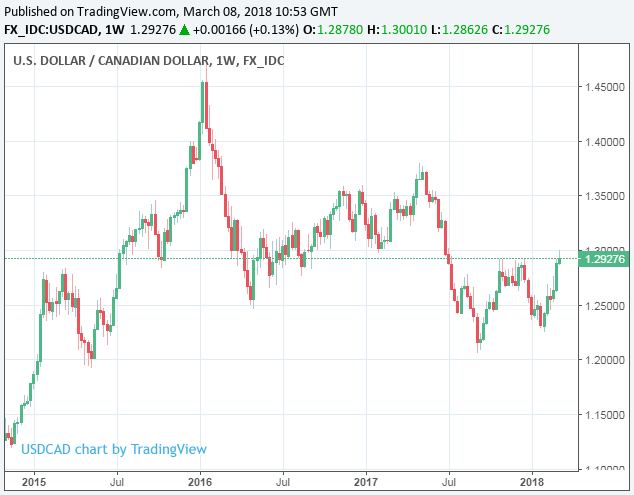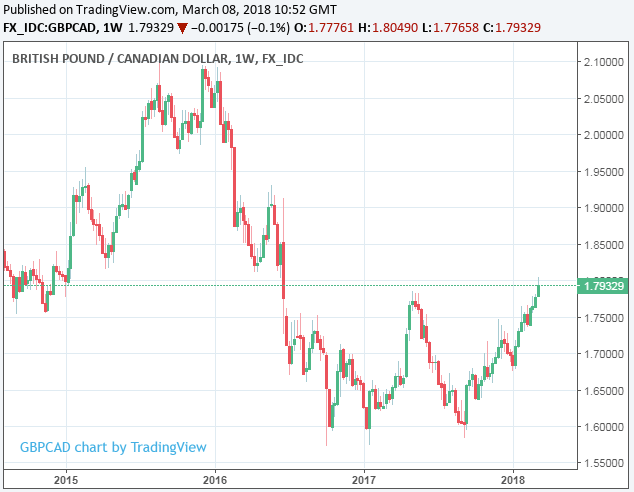Canadian Dollar Forecasts Downgraded at CBA but USD/CAD, GBP/CAD are Still Expected to Fall
- Written by: James Skinner
-

© Rawpixel.com, Adobe Stock
“The uncertainty over the future of the North American Free Trade Agreement (NAFTA) has turned out to be a bigger drag on CAD than we originally anticipated."
The Canadian Dollar outlook has dimmed of late, given extended uncertainty over external trade relations and waning confidence in the Bank of Canada’s ability to maintain its recent pace of rate hikes, prompting strategists at Commonwealth Bank of Australia to downgrade their forecasts for the Loonie.
That said, Commonwealth strategists say the Loonie is still overdue a correction higher, given the extent of its 2018 losses to date and owing to an encouraging domestic economic picture.
They forecast the Canadian Dollar will rise steadily against the US Dollar and Pound Sterling throughout the rest of 2018, albeit a steadier and shallower upward path.
After a solid performance in the final months of last year, the Canadian Dollar has been the worst performing G10 currency so far in 2018, with its steepest losses coming against the Japanese Yen, British Pound, Euro and Swiss Franc.
It is down more than 8% against the Yen and by 5% relative to Sterling, the Euro and Franc. The Loonie has even given ground to the beleaguered US Dollar, with the USD/CAD rate having risen by 2.7% in the last two and a bit months.
“The uncertainty over the future of the North American Free Trade Agreement (NAFTA) has turned out to be a bigger drag on CAD than we originally anticipated. In fact, the Canadian dollar has underperformed all major currencies since the start of the year,” says Elias Haddad, a senior currency strategist at Commonwealth Bank of Australia.

Above: USD/CAD rate shown at weekly intervals.
Trade concerns have become an increasingly heavy weight around the ankles of the Canadian Dollar in recent months.
Efforts to renegotiate the North American Free Trade Agreement have rolled on without success, while an increasingly belligerent attitude from Washington on trade in general has hit market more broadly in March.
President Donald Trump is expected to formally announce new tariffs on imports of aluminium and steel later on Thursday given that Canada is supposedly the largest steel and aluminium supplier to the United States.
Washington says the move is intended to protect American steel producers, and jobs, from dumping by state-subsidised foreign producers although it is thought the tariffs will be applied to imports across the board, from all countries.
US trade representative Peter Navarro said Wednesday that Canada and Mexico would be exempted from the new tariffs until the NAFTA renegotiation is wrapped up.
"The comments have helped to ease downward pressure on the Canadian dollar after USD/CAD failed to break back above the 1.3000-level yesterday," says Lee Hardman, a currency analyst at MUFG.
Nonetheless, the latest trade rhetoric from Washington merely adds further risk to the Canadian Dollar, given its vulnerability to a possible US decision to withdraw from the NAFTA accord over the coming months.
“A breakdown in NAFTA negotiations is a clear and present danger which can ultimately lead to a more pronounced undershoot in CAD against USD and AUD as speculators may be compelled to unwind their stale long CAD exposure,” says Haddad.
There are a number of aspects to the existing agreement the US President has taken issue with. Some analysts have speculated that a US withdrawal from the pact could lead to a double digit devaluation of the Canadian Dollar.
"We expect USD/CAD to begin to stabilize between the 1.2500 and 1.3000-levels in the near-term, should Trump confirm that Canada has been exempted from the steel & import tariffs," MUFG's Hardman says, in a note Thursday.
"USD/CAD will likely struggle to sustain levels back above the 1.3000-level unless there is a more significant breakdown in trading relations with the US, such as a breakdown in Nafta talks."

Above: Pound-to-Canadian-Dollar rate shown at weekly intervals.
Advertisement
Get up to 5% more foreign exchange by using a specialist provider to get closer to the real market rate and avoid the gaping spreads charged by your bank when providing currency. Learn more here.
Bank of Canada Shifts into Slow Lane
Trade concerns are undeniably a big factor in the Canadian Dollar’s weakness although, a meaningful portion of its losses are also the result of shifting expectations for interest rates in Canada and elsewhere over the coming months.
“Our base case scenario remains for the BoC to raise the policy interest rate (currently at 1.25%) one more time in 2018 (25bps in October) and twice in 2019 (25bps in April 2019 and 25bps in October 2019). This implies a BoC policy rate of 2.00% by year-end 2019 which bodes well for CAD,” says Haddad.
The Bank of Canada raised the cash rate by 25 basis points to 1.25% in January, making for the third rate hike in nine months, and held steady at that level in March.
Interest rate derivatives market pricing on January 18, the day when the BoC last raised rates, implied an October 2018 cash rate of 1.77%. However, this implied rate had fallen to just 1.66% by March 08, suggesting markets only expect one more rate rise from the BoC in 2018.
At the same time, market expectations of interest rate rises from the Federal Reserve and Bank of England in 2018 have improved, while the ECB has also signalled a change in its interest rate guidance could be forthcoming in the months ahead.
For example, on January 17 markets had the midpoint of the Federal Funds rate range at 1.99% in November although, by March 08, this November rate had risen to 2.08%.
The change suggests markets now expect four rate hikes from the Federal Reserve in 2018 and not the three that were priced back in January.
However, as much as the change in relative monetary policy expectations may have weighed on the Loonie in recent months, Commonwealth Bank say this effect will not last for long as the Loonie is beginning to look cheap.
“The current uptrend in Canada’s terms of trade will generate a positive net wealth effect to the overall economy and raise the Canadian dollar’s fundamental value,” Haddad writes in a note Thursday.
“Interestingly, the Canadian real effective exchange rate is currently slightly below the level implied by Canada’s terms of trade. This will underpin CAD.”
Currency Forecasts
Haddad and the Commonwealth Bank FX team are forecasting a steady rise for the Canadian Dollar during the rest of 2018, albeit a slower and more shallow ascent than their earlier projections implied.
The USD/CAD rate is forecast to fall from an expected level of 1.28 at the end of March to 1.27, 1.25 and 1.23 respectively by the end of June, September and December.
This implies a loss of 4.8% for the USD/CAD rate, which traded at 1.2925 during the morning session Thursday, before the end of the year.
Commonwealth Bank forecasts of 1.37, 1.387, 1.40 and 1.42 for the Pound-to-Dollar rate over the same timeframe, which implies they expect to see a steady move lower for the Pound relative to the Canadian Dollar.
The Pound-to-Canadian-Dollar pair is, after all, a foreign exchange cross rate that is calculated at its most basic level by dividing the Pound-to-Dollar rate over the CAD/USD rate.
Commonwealth’s implied forecast is for the Pound to fall from its 1.7938 level against the Canadian Dollar Thursday, to 1.7537 by the end of March. It is then projected to follow a shallow path lower throughout the rest of the year, to 1.7466 by the end of December.
Advertisement
Get up to 5% more foreign exchange by using a specialist provider to get closer to the real market rate and avoid the gaping spreads charged by your bank when providing currency. Learn more here.










